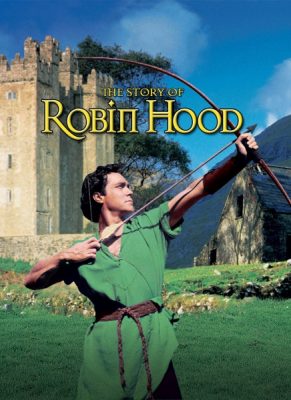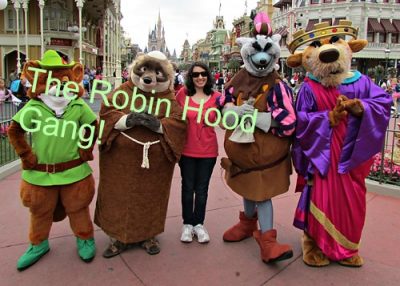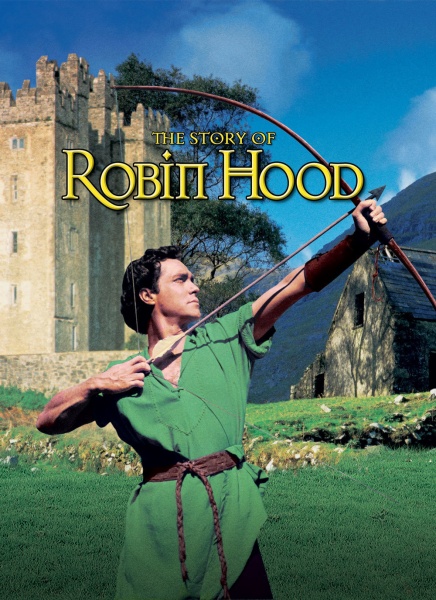
Based on the legendary figure from English folklore, Disney’s The Story of Robin Hood and His Merrie Men was theatrically released on June 26, 1952. The live action adventure drama, Disney’s second completely live action film after Treasure Island (1950), is eighty-four minutes in length.
Plot Summary
In 1190, the Earl of Huntingdon (Clement McCallin) leaves his manor to join King Richard (Patrick Barr) on a Crusade. Through the duration of the fight, Huntingdon’s daughter, Maid Marian (Joan Rice), will be protected by Queen Eleanor (Martita Hunt), and, in more consequence for the kingdom, Richard’s younger brother Prince John (Hubert Gregg) will govern. To John’s credit, he fulfills Richard’s request to give “firm guidance” to the Midland Counties. To John’s discredit, however, he does not undertake this action for the betterment of the kingdom; rather, his actions are predicated on self-aggrandizement. Through the newly-appointed Sheriff of Nottingham (Peter Finch), who gained his role after the former sheriff was allowed to join the Crusade just prior to its departure, John raises taxes to unmanageable levels, rates justified by John and the Sheriff under the pretense of needing a strong army to maintain order in Sherwood Forest but mainly collected to line the rulers’ pockets.
Leading the popular fight against John and the Sheriff is Robin Fitzooth (Richard Todd), the son of the Earl of Huntingdon’s chief verdurer, Hugh Fitzooth (Reginald Tate), and Marian’s overt lover. Outlawed after shooting one of the Sheriff’s foresters in retaliation for said forester’s murder of Robin’s father, Robin, who, along with his still-living father, had refused to serve the Sheriff in spite of a direct invitation, gradually gathers a band of followers who contest John’s usurpation of power by stealing from the rich to give to the poor. Robin Hood’s followers include Little John (James Robertson Justice), Friar Tuck (James Hayter), and the melodious Allan-a-Dale (Elton Hayes).
Both the followers of Prince John and those of Robin Hood are determined and cunning. After a two-year interval, the latter strive to raise 100,000 marks to secure King Richard’s release from an Austrian prison, while the former cry poverty such as to prevent Richard’s return and, thus, retain power. Which side will win?
Shorts
The Story of Robin Hood and His Merrie Men was accompanied by two short productions during its theatrical run. (1) The first of these efforts, “Water Birds,” was a nature short, part of Walt Disney’s “True-Life Adventures” series, which included fourteen nature productions between 1948 and 1960. The second short was “The Little House,” an animated effort about an abandoned rural dwelling lost in an urban setting, which was narrated by Sterling Holloway. Holloway, who was named a Disney Legend in 1991, voiced numerous characters in Disney’s animated classics over the years, including the Stork in Dumbo (1941), Cheshire Cat in Alice in Wonderland (1951), Kaa in The Jungle Book (1967), Roquefort in The Aristocats (1970), and Winnie the Pooh in the segments of The Many Adventures of Winnie the Pooh (1977); and he also provided narration for the “The Cold-Blooded Penguin “ short in The Three Caballeros (1944), the “Peter and the Wolf” short in Make Mine Music (1946), the “Lambert the Sheepish Lion” short (1952), the “Susie the Little Blue Coupe” short (1952), and the “Ben and Me” short (1953).
Production
As had been the case with Treasure Island, The Story of Robin Hood was produced in Britain such as to take advantage of funds frozen in Britain after World War II. (2)
The Story of Robin Hood was the first completely live action effort for Disney Renaissance Man Bill Walsh, who, like Sterling Holloway, was named a Disney Legend in 1991. (3) Walsh had started with Disney in 1943 by writing Mickey comic strips; gained further prominence in 1947, when he brought ventriloquist Edgar Bergen, a former client, to the studio to provide narration and humor for Fun and Fancy Free; and saw his value skyrocket in the 1950s through his initially-hesitant efforts in producing and writing some of Disney’s most beloved television shows and movies, including ABC-TV’s “Disneyland,” “The Mickey Mouse Club,” The Absent-Minded Professor (1961), Son of Flubber (1963), Mary Poppins (1964), That Darn Cat! (1965), and The Love Bug (1969). (4)
Confused at Disney’s invitation to join him in England for production of The Story of Robin Hood, Walsh was prodded, “There’s a funny little magic word called ‘initiative,’ and that will tell you what to do.” (5) After pondering ideas, Walsh decided to create a fifteen-minute behind-the-scenes segment about the film’s production. The short, “The Riddle of Robin Hood,” was used on television to promote the film and inspired similar works for future live action films, many of which nowadays delight viewers as extras on DVD rereleases of Disney’s classic movies. (6)
Peter Ellenshaw, who was named a Disney Legend in 1993, contributed twelve matte paintings to the film. (7) Early in the movie, for example, the Earl of Huntingdon and Marian journey across a bridge and up a large hill towards a distant castle, where King Richard is awaiting the commencement of the Crusade. In reality, the actors were traveling on relatively barren turf with a slight incline—the bridge, the castle, and the high incline were painted in by Ellenshaw. (8)
Excitement
Action abounds in The Story of Robin Hood and His Merrie Men. The excitement includes a thunderous sendoff for the Crusaders; an archery tournament; a public flogging and a daring counterattack by Robin Hood; vegetables and a chorus of boos thrown at the Sheriff of Nottingham by an angry populace; a stick fight between soon-to-be allies Robin Hood and Little John over the right to cross a bridge; a sword fight between soon-to-be allies Robin Hood and Friar Tuck; and various battles between Robin Hood’s men and the Sheriff’s allies, including a confused engagement with the Queen’s entourage carrying the ransom funds to Austria.
Additionally, as the film’s title hints, the vibe amongst Robin Hood’s men is merry with lots of toasts and laughter serving to override otherwise dark content.
Music
The Story of Robin Hood and His Merrie Men incorporates great background music, which varies depending on the circumstances. For example, a playful tune abruptly turns ominous early in the film when Tyb (Louise Hampton) arrives to end Marian’s visit with Robin, an enchanting number accompanies Marian’s introduction to the Queen, and suspenseful and dramatic tunes augment the riding and fighting segments.
The film’s most memorable music comes through the regular ballads of the minstrel Allan-a-Dale. The short songs cannot compare with the more substantial ballads from Davy Crockett, King of the Wild Frontier (1955), Davy Crockett and the River Pirates (1956), and Johnny Tremain (1957), but they are nonetheless fun.
Friar Tuck humorously alternates accents while singing to himself, and Robin Hood adds his voice to the proceedings.
Relationship to Other Disney Films
The Story of Robin Hood and His Merrie Men was the first of four Disney films directed by Ken Annakin, who was named a Disney Legend in 2002. Annakin subsequently directed The Sword and the Rose (1953), Third Man on the Mountain (1959), and Swiss Family Robinson (1960) for the studio.
Disney released an animated Robin Hood in 1973. The film’s anthropomorphic characters may be seen in Disney’s theme parks on extremely rare occasions.

Overall
Successfully mixing festivity, suspense, action, and romance, The Story of Robin Hood and His Merrie Men is a fun, lighthearted film.
Notes
1) W., A. (1952, June 27). Disney’s ‘Story of Robin Hood’. New York Times, p. 18. Retrieved August 5, 2017, from https://libproxy-cc-stonybrook-edu.proxy.library.stonybrook.edu/login?url=https://search-proquest-com.proxy.library.stonybrook.edu/docview/112287745?accountid=14172; Crowther, B. (13, July 1952). GIVE ‘EM ROBIN HOOD: A Successful Application of an Old Formula for Success on the Screen. New York Times, p. X1. Retrieved August 5, 2017, from https://libproxy-cc-stonybrook-edu.proxy.library.stonybrook.edu/login?url=https://search-proquest-com.proxy.library.stonybrook.edu/docview/112241858?accountid=14172; An ‘All Walt Disney’ Show. (n.d.). Retrieved August 5, 2017, from http://disneysrobin.blogspot.com/2010/01/above-is-copy-of-advertisement-for.html?m=1.
2) Watts, S. (1997). The Magic Kingdom: Walt Disney and the American Way of Life (p. 291). Columbia, Missouri: University of Missouri Press.
3) Bill Cotter comment on The Riddle of Robin Hood. (2010, February 15). Retrieved August 6, 2017, from http://disneysrobin.blogspot.com/2008/01/riddle-of-robin-hood.html.
4) Watts (1997), pp. 377-82; Bill Walsh. (n.d.). Retrieved August 6, 2017, from https://d23.com/walt-disney-legend/bill-walsh/.
5) Watts (1997), p. 377.
6) Ibid.; The Riddle of Robin Hood. Retrieved August 6, 2017, from http://disneysrobin.blogspot.com/2008/01/riddle-of-robin-hood.html.
7) Peter Ellenshaw. Retrieved August 13, 2017, from http://disneysrobin.blogspot.com/2011/03/peter-ellenshaw.html.
8) “Little People, Big Effects” [DVD] (2004). United States: Disney. Approximately 11-minute segment featured on 2004 DVD release of Darby O’Gill and the Little People (1959).
What do you think of The Story of Robin Hood and His Merrie Men? Let me know in the comments!
Sponsored Ad: Would you like to help support The Mouse For Less website in continuing their mission of being THE Disney vacation planning resource? You can do so by purchasing Robin Hood and His Merrie Men from our Affiliate Link through Amazon. Thanks so much for your support!
Did you like this article? Make sure to share it with your friends! Check below for easy ways to share!

